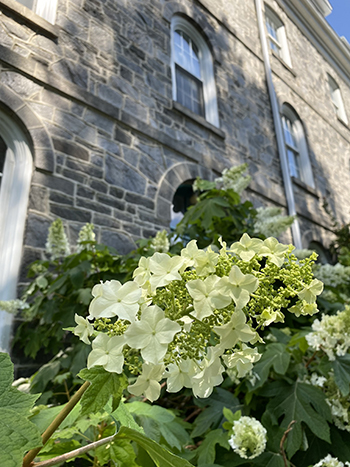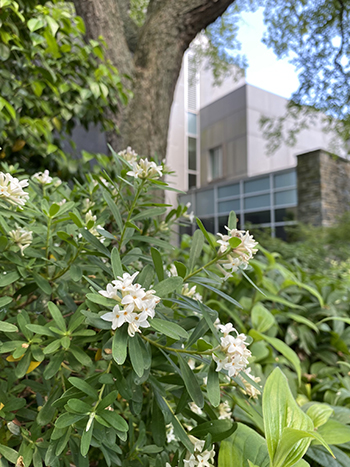
Plants of the Week: June 3
Guest Author: Patty Lally, 2024 Summer Intern

Hydrangea quercifolia ‘Ellen Huff’
As we continue to get a glimpse of the summer heat, that means it is time for hydrangea season! Hydrangea quercifolia ‘Ellen Huff’, also known as oakleaf hydrangea, features white blooms arranged in pyramidal erect panicles, with leaves resembling those of an oak (Quercus sp.) as the specific epithet suggests. It may be tempting to cut these flowers and put them in a vase, but don’t cut them all! The white flowers will eventually transition into a light pink as the leaves begin to shift into a deep burgundy. The cultivar, ‘Ellen Huff’ in particular, has been bred to tolerate heat more successfully, and to reach heights around 6- to 8-feet tall.
This hydrangea will bloom on old wood, thus be sure to prune around the end of July, or when they stop flowering. You’ll want to plant this hydrangea in partial to full shade with well drained soils due to its shallow root system. You can visit Hydrangea quercifolia ‘Ellen Huff’ along Parrish Hall across from the West Circle.

Daphne x transatlantica [Eternal Fragrance®] ‘Blafra’
For gardeners looking to add some fragrance to their garden, take a look at Eternal Fragrance® daphne, Daphne x transatlantica ‘Blafra’. This semi-evergreen shrub comes with a delightful floral fragrance, and grows to about 2- to 3-feet tall and wide.
This particular cultivar was bred for its continuous bloom. Small, but abundant, blush pink to white flowers will begin to bloom in the springtime and continue throughout autumn. New flowers will bloom on new growth in time, making it an excellent and elegant addition to a fragrance garden. Its glossy leaves will provide winter interest as long as it doesn’t get too cold.
However, don’t be fooled by its beautiful appearance! Being a daphne, this shrub is toxic if ingested, and may irritate the skin if its sap comes into contact with the skin. It’s best to plant ‘Blafra’ in well drained, sandy soil in full sun or partial shade. Keeping the soil moist is recommended, and requires little pruning. Try finding Eternal Fragrance® daphne in the Harry Wood Garden.

Itea virginica [Little Henry®] ‘Sprich’
In celebration of our graduating seniors, let’s take a look at our next plant Little Henry® Virginia sweetspire, Itea virginica ‘Sprich’. While this is not the specific itea plant given out to the graduating class, this itea is a dwarf version of ‘Henry’s Garnet’. This cultivar exhibits all the great qualities of ‘Henry’s Garnet’ such as the beautiful garnet foliage in the fall. This is another plant that comes with white flowers and a lovely scent. The flowers in particular are long and shoot out in racemes, and will attract bees and butterflies.
This plant also happens to be low maintenance, and should be planted in full sun to partial shade in well drained soils. Virginia sweetspire has the ability to sucker and create a colony. Root suckers can be removed to prevent naturalization. If you’re looking to replace your burning bush, give this itea a try! You can find Little Henry® Virginia sweetspire in the Glade Garden.





MS
Posted at 19:19h, 04 JuneVery informative, thank you!
Robert Roggeveen
Posted at 07:31h, 06 JuneMight there be places to add one or more of these to my garden in West Hartford (Conn.)? Perhaps. In any event, a treat to read every Plants of the Week.